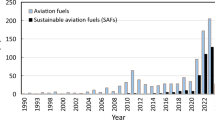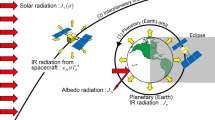Abstract
The optimal trajectories of the mission to the “hazardous” asteroid Apophis, designed to study the asteroid, taking samples of its soil and returning to the Earth, are constructed and analyzed. The scheme of transfer with applying chemical “high”-thrust jet propulsion systems is used. For the transfer to the asteroid in 2019–2022, with the total mission duration being up to two years, the optimal-in-payload-mass, three-impulse trajectories of spacecraft, are obtained. The principal possibility of accomplishing the Earth–Apophis–Earth space mission, based on launch vehicles (LVs) of “Soyuz” type and “Fregat” upper stage, during the transfer in 2019–2022, is demonstrated.







Similar content being viewed by others
REFERENCES
Atkins, K.L., Brownlee, D.E., Duxbury, T., et al., STARDUST: Discovery’s InterStellar dust and cometary sample return mission, 1997 IEEE Aerospace Conference, IEEE, 1997, vol. 4, pp. 229–245.
Sandford, S.A., The power of sample return missions–Stardust and Hayabusa, Proceedings of the International Astronomical Union Symposium, 2011, vol. 280, pp. 275–287.
Ajluni, T., Everett, D., Linn, T., et al., OSIRIS-REx, returning the asteroid sample, 2015 IEEE Aerospace Conference, IEEE, 2015, pp. 1–15.
Asteroido-kometnaya opasnost’: vchera, segodnya, zavtra (Asteroid–Comet Hazard: Yesterday, Today, and Tomorrow), Shustov, B.M. and Rykhlova, L.V., Eds., Moscow: Fizmatlit, 2010.
Sokolov, L.L., Bashakov, A.A., Borisova, T.P., et al., Impact trajectories of the asteroid Apophis in the 21st century, Sol. Syst. Res., 2012, vol. 46, no. 4, pp. 291–300.
Avtomaticheskie kosmicheskie apparaty dlya fundamental’nykh i prikladnykh nauchnykh issledovanii (Automatic Spacecraft for Basic and Applied Scientific Research), Polishchuk, G.M. and Pichkhadze, K.M., Eds., Moscow: MAI, 2010.
Ivashkin, V.V. and Lang, A., Optimal space trajectories for the Earth–Apophis–Earth mission using high thrust engines, Kosmonavt. Raketostr., 2017, no. 5, pp. 63–71.
Ivashkin, V.V. and Lang, A., Optimum trajectories for an Earth–asteroid–Earth mission with a high thrust flight, Dokl. Phys., 2019, vol. 64, no. 1, pp. 14–19.
Hohmann, W., Die Erreichbarkeit der Himmelskörper, München–Berlin: R. Oldenbourg, 1926.
Tsiolkovsky, K.E., World space research using jet vehicles (1911–1912), Pionery raketnoi tekhniki. Kibal’chich. Tsiolkovsky. Tsander. Kondratyuk. Izbrannye trudy (The Pioneers of Rocket Engineering: Kibal’chich, Tsiolkovsky, Tsander, and Kondratyuk. Selected Works), Moscow: Nauka, 1964.
Lang, A., Analysis of spacecraft trajectories for the space mission Earth–Apophis–Earth and the spacecraft orbital motion around the asteroid Apophis, Inzh. Zh.: Nauka Innovatsii, 2017, no. 7.
Ivashkin, V.V., Optimizatsiya kosmicheskikh manevrov pri ogranicheniyakh na rasstoyaniya do planet (Optimization of Space Maneuvers with Limited Distances to the Planets), Moscow: Nauka, 1975.
Il’in, V.A. and Kuzmak, G.E., Optimal’nye perelety kosmicheskikh apparatov s dvigatelyami bol’shoi tyagi (Optimal Transfer Orbits of Spacecraft with High Thrust Engines), Moscow: Nauka, 1976.
Kubasov, V.N. and Dashkov, A.A., Mezhplanetnye polety (Interplanetary Flights), Moscow: Mashinostroenie, 1979.
Sobol’, I.M. and Statinkov, R.B., Vybor optimal’nykh parametrov v zadachakh so mnogimi kriteriyami (Choice of Optimal Parameters for Multiple Criteria Problems), Moscow: Nauka, 1981.
Numerical Recipes in C: The Art of Scientific Computing, Press, W.H., Teukolsky, S.A., Vetterling, W.T., , Eds., Cambridge University Press, 1992.
Sobol’, I.M., Asotsky, D., Kreinin, A., et al., Construction and comparison of high-dimensional Sobol’ generators, Wilmott J., 2012, vol. 2011, no. 56, pp. 64–79.
Panchenko, T.V., Geneticheskie algoritmy: uchebno-metodicheskoe posobie (Genetic Algorithms: A Study Guide), Astrakhan: Astrakhanskii univ., 2007.
Nocedal, J. and Wright, S.J., Numerical Optimization, New York: Springer, 2006.
Ivashkin, V.V. and Lang, A., Trajectory optimality analysis for the Earth–asteroid–Earth mission, Preprint of Keldysh Institute of Applied Mathematics, Russ. Acad. Sci., Moscow, 2017, no. 113. https://doi.org/10.20948/prepr-2017-113
Lawden, D.F., Optimal Trajectories for Space Navigation, London: Butterworths, 1963.
Charnyi, V.I., On isochronous derivatives, Iskusstvennye sputniki Zemli (Artificial Earth Satellites), Moscow: Akad. Nauk SSSR, 1963, vol. 16, pp. 65–79.
Pines, S., Constants of the motion for optimum thrust trajectories in a central force field, AIAA J., 1964, vol. 2, no. 11, pp. 2010–2014.
Lion, P.M. and Handelsman, M., Primer vector on fixed-time impulsive trajectories, AIAA J., 1968, vol. 6, no. 1, pp. 127–132.
Jezewski, D.J. and Rozendaal, H.L., An efficient method for calculating optimal free-space N-impulse trajectories, AIAA J., 1968, vol. 6, no. 11, pp. 2160–2165.
Robbins, H.M., An analytical study of the impulsive approximation, AIAA J., 1966, vol. 4, no. 8, pp. 1417–1423.
Zakharov, Yu. A., Proektirovanie mezhorbital’nykh kosmicheskikh apparatov (Design of Interorbital Space Vehicles), Moscow: Mashinostroenie, 1984.
Khokhulin, V.S. and Chumakov, V.A., Proektirovanie kosmicheskikh razgonnykh blokov s ZhRD (Design of Space Accelerating Blocks with Liquid Rocket Engines), Moscow: MAI, 2000.
Bychkov, A.D. and Ivashkin, V.V., Design and ballistic analysis of a reusable Earth–Moon–Earth transportation system based on nuclear thermal rocket engine, Kosmonavt. Raketostr., 2014, no. 1, pp. 68–76.
Abbasov, M.E., Metody optimizatsii (Optimization Methods), St. Petersburg: VVM, 2014.
ACKNOWLEDGMENTS
In conclusion, the authors express their sincere gratitude to the staff of S.A. Lavochkin RPA: Ph. D. V.G. Paul and Ph. D. A.V. Simonov, as well as to Ph. D. I.V. Krylov for support and useful discussions of the study, as well as to participants of the V.A. Egorov seminar at the M.V. Lomonosov Moscow State University for very useful discussions of the problem and this study. The authors are grateful to graduate student Guo Peng for his help in improving the computer program and in performing calculations. V.V. Ivashkin thanks Prof. J. Martinez-Garcia, Dr. M. Bello-Mora, Dr. E. Revilla-Pedreira, Prof. P. Sanz-Arangues and Prof. T. Elices (GMV, Madrid Polytechnic University) for their support in studying the problem of flight to small celestial bodies.
Author information
Authors and Affiliations
Corresponding authors
Additional information
Translated by Yu. Preobrazhensky
Rights and permissions
About this article
Cite this article
Ivashkin, V.V., Lan, A. Construction of the Optimal Trajectories for the Earth–Asteroid–Earth Mission under High-Thrust Flight. Cosmic Res 58, 111–121 (2020). https://doi.org/10.1134/S0010952520020057
Received:
Revised:
Accepted:
Published:
Issue Date:
DOI: https://doi.org/10.1134/S0010952520020057




